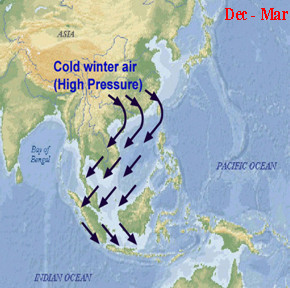
Late October and November bring the monsoon season on the eastern side, with heavy rain, strong winds, and choppy seas, making travel more difficult. On the west coast, the weather remains mild and dry, with little rainfall until February.
Monsoon Season
The weather in Malaysia is characterized by two monsoon regimes, namely the Southwest Monsoon that starts from late May to September, and the Northeast Monsoon from November to March. The Northeast Monsoon brings heavy rain especially to the states on the east coast of Peninsular Malaysia, west of Sarawak and east of Sabah, while the Southwest Monsoon relatively shows drier weather. The transition period between these two monsoons is known as the inter-monsoon phase. Monsoon occurs due to the temperature difference between the land and the ocean as a result of the heating of the sun\\\'s rays. During winter, the landmass of the continent cools faster and causes extremely low temperatures in Central Asia. This situation caused the atmospheric pressure to increase and formed a very strong high pressure system (anticyclone) in Siberia. As a result, cold air moves out of Siberia as a northwesterly wind and then turns into a northeasterly wind when it reaches the coastal waters of China before heading to Southeast Asia.\\r\\n\\r\\n\\r\\n The Malaysian Meteorological Department (MetMalaysia) predicted that the northeast monsoon period would begin on 7 November 2022, which was earlier than expected and continue until March 2023. This prediction has now materialized and the current monsoon rain will continue through March. This persistent raining, which has deteriorated since 28 February 2023, has caused flooding in the Malaysian peninsula, affecting the states of Johor, Melaka, Negeri Sembilan, Pahang and Selangor. Johor is the worst-hit state with more than 42,000 people evacuated to relief centres since 4 March 2023, compared to 9,162 on 1 March. There has been ongoing flooding from the same monsoon season which started in December 2022, but the current flooding is above average, as a similar scope which has never been experienced in March. Earlier in February 2023, Johor experienced minor flooding, which was expected in terms of timing and scale, but the scale of current flooding is extraordinary.\\r\\n\\r\\n\\r\\n The inter-monsoon season is expected to begin on Thursday (March 2023) and continue until mid-May, marking the end of the Northeast Monsoon which began on Nov 7 last year. Malaysian Meteorological Department (MetMalaysia) director-general Muhammad Helmi Abdullah, in a statement, said during this phase, the country would receive weak winds from various directions which would form thunderstorms that usually bring heavy rain and strong winds in a short period. \\\"This normally happens in the afternoon and late evening in most areas on the west coast and interiors of the Peninsular, western Sabah as well as central Sarawak. These conditions have the potential of causing flash floods and damage to unstable structures,\\\" he said.

